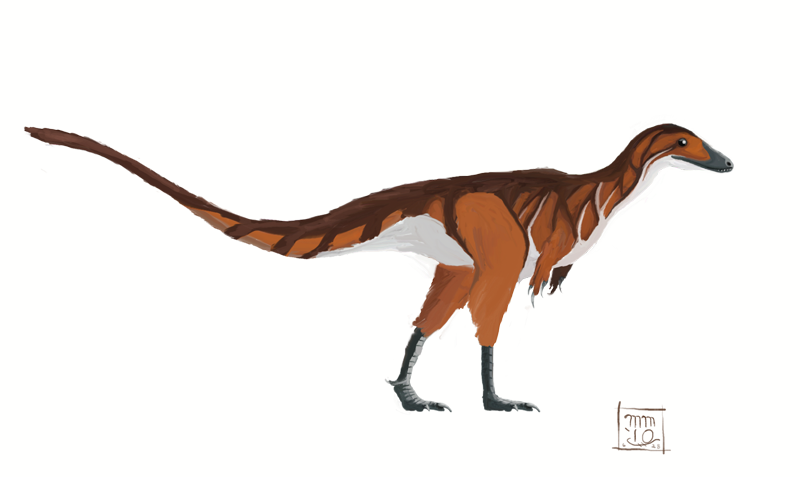home > natural history
"Sinosauropteryx" sp.
unnamed species

Several specimens have been referred to Sinosauropteryx since it was described in 1996. The type specimen was a juvenile individual, and several adults have turned up since. The adults differ in some minor proportions, as expected due to changes during growth. One specimen, however, differs more than the rest. This is specimen number 2124 in the collection of the Geological Museum of China. Paleontologist Nick Longrich, in the same lecture to the Society of Vertebrate Paleontology in which he first noted the banded color pattern preserved in some specimens, pointed out that GMV 2124 may only be distantly related to Sinosauropteryx prima.
GMV 2124 is superficially very similar to its more famous cousin, though most of those similarities are due to the conservative body plans found among primitive coelurosaurs: triangular skull, short arms, long tails, and small size. However, GMV 2124 has a much shorter tail than Sinosauropteryx, as well as a shorter torso, more 'normal' theropod finger proportions (unlike the stubby fingers of S. prima), and longer legs with proportionally longer tibia and foot bones, better suited to running than its squat relatives. Longrich theorized that GMV 2124 was a compsognathid coelurosaur while the true Sinosauropteryx was more primitive, even perhaps a primitive allosauroid. While this isn't supported in some unofficial studies published online (where both seem to be compsognathids), the idea has yet to be thoroughly tested in the scientific literature.
The Interestingly, GMV 2124 is among the Yixian fossils which preserve remanants of the animal's last meal. In this case, the little coelurosaur had apparently fed on three small mammals before it died (one Sinobataar linguanensis, a multituberculate, and two Zhangheotherium quinquecuspidens, a symmetrodont), the jaws of which were found in its stomach cavity.
Image Details:
Media: Digital painting, Adobe Photoshop CS3
using WACOM Graphire 3
License:
ALL RIGHTS RESERVED
DESCRIPTION
Length: 1m (3.3ft)
Weight: 260g (9oz)
Location: Yixian Formation, Liaoning, China
Time: Aptian age, Lower Cretaceous (125Ma)
CLASSIFICATION
Kingdom: Animalia
Phylum: Chordata
Class: Stem-Aves
Order: Compsognatha
Family: Compsognathidae
Genus: Unnamed
Species: Unnamed
SYSTEMATICS
Sauropsida
Diapsida
Archosauria
Ornithosuchia
Dinosauria
Theropoda
Coelurosauria
Comosognathidae